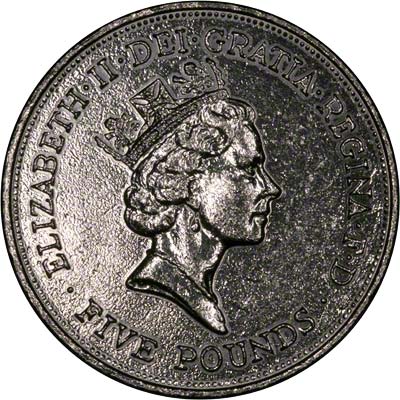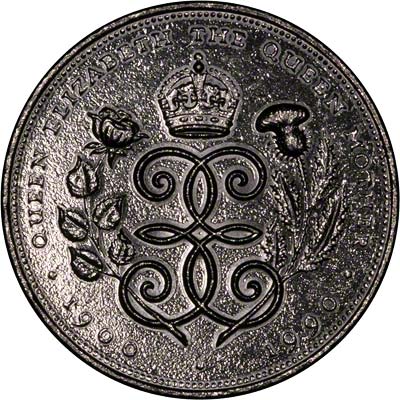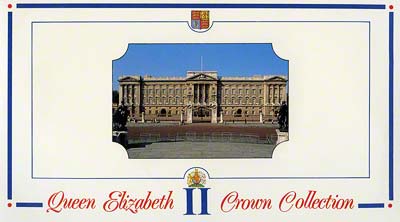| The Very Highest Quality British Crowns... |
| Royal Mint Crown Collection Cock-Up |
|

Obverse of Tumble Polished 1990 Queen Mother's 90th Birthday Crown |
 Reverse of Tumble Polished 1990 Queen Mother's 90th Birthday Crown |
 Inside Cover of Tumble Polished 1953 to 1990 Royal Mint Crown Collection |
A Barrel of Balls
The Royal Mint took sets of 8 perfectly good crowns, ruined them by barrel polishing them (it could have been a vibratory polisher) , and sold them repackaged. To most coin dealers and collectors this would constitute stupidity of mind boggling proportions.
We will be photographing some of these as evidence, and will show them here shortly.
Secondary Market Sourcing
Although the Royal Mint mainly markets its new products, it has also taken to re-issuing existing coins, usually repackaged, and sometimes re-assembled into new sets.
When this happens, they do not simply mint more of the historic coins, which would undermine existing markets and destroy confidence, but buy them from one or more selected coin dealers who supply them on a contract basis with the desired quantities of secondary market sourced coins. There is nothing wrong with this, although trying to buy up matching quantities of each coin sometimes distorts the market and temporarily drives up market prices on one or two coins to relatively high levels which then drop back once the order is filled.
Reverse Quantity Discounts
Most businesses would expect to pay lower prices when they buy in larger quantities. It is a strange anomaly, at first sight, in the second-hand goods markets, that buyers often have to pay higher prices if they wish to buy large quantities. This is somewhat counter-intuitive, but it is not difficult to understand why. We will try to give a simple example:
Most coin dealers will accumulate excess quantities of certain coins, perhaps the very popular (at the time) 1977 Silver Jubilee Crowns. Every man and his dog bought or acquired one of these at the time. Years later, when Jubilee jubilation faded, people came to dispose of these, and most coin dealers end up with boxes, drawers, bins or other containers full of these in their excess inventory. Most dealers probably pay face value 25 pence each. If a collector wants to buy one, the dealer is usually happy to reduce his surplus stock, and probably asks somewhere between 50 pence and £1 for a single coin, which is probably a selected specimen from his stock. It may also come at no extra charge complete with a plastic case which would originally have cost extra. Other dealers will vary, but we have a minimum charge of £1 for a single coin because we reckon it costs about 50 pence or more to serve a customer. If a buyer wanted 10 pieces we would be happy to quote a lower price, and for 100 pieces we would be even more keen to deal, subject to stock.
This last provision is important. We would usually be very wary of committing to sell a larger quantity than we held in stock. The reason for this is that if we had to source from another dealer, we might have to pay more than our selling price, it could be time-consuming chasing round trying to acquire more coins, and inward transport costs may make things worse. Also if other dealers were in the same position, we might find there was a severe temporary shortage, and an acute price squeeze.
Simple economic theory would explain it by the fact that a temporary increase in demand would soak up and possibly exceed supply. It is therefore expected that prices would increase to encourage supply to increase and meet the demand.
Factors like this would mean that the Mint had to pay an inflated price to source sufficient quantities of coins. The alternative is to acquire them more slowly, but this adds to the storage and financing costs.
Official Vandalism
We cannot remember when we first saw one of these collections, but when we did, we were at first horrified by the condition of the coins. They had apparently been subjected to a harsh industrial cleaning and polishing process, almost certainly barrel polishing (although it could have been a vibratory polisher). This can be one of a variety of methods. We found a simple explanation on the website of a specialist company:
After heat treatment and annealing, burnishing is employed to make the surface of the coin blanks brighter, remove any surface scaling or discoloration and in some cases apply a minute amount of lubricant to assist in coining. This process is carried out in a Vibratory or Centrifugal Finishing Machine that tumbles the coin blanks with a mixture of stainless steel balls (inox) and special chemicals, which etch and polish and brighten the surface of the coins.Most factories producing small metal components will use a similar technique to de-burr and polish components before further processing. Most mints almost certainly pre-polish blanks before striking, especially when producing specimen or proof coins with a high grade finish.
The burnishing operation is also employed after stamping of the coins.We find this very hard to believe, and find it difficult to imagine when this would be desirable. Certainly not when making specimen or proof coins.
The Eight Crowns
| Date | Event | Mintage | Face Value | Catalogue Value* |
| 1953 | Coronation | 5,963,000 | 5/- (£0.25) | £3 |
| 1960 | British Exhibition in New York | 1,024,000 | 5/- (£0.25) | £5 |
| 1965 | Churchill Memorial | 9,640,000 | 5/- (£0.25) | £0.75 |
| 1972 | Royal Silver Wedding Elizabeth & Philip | 7,452,000 | £0.25 | £0.75 |
| 1977 | Silver Jubilee | 36,989,000 | £0.25 | £0.60 |
| 1980 | Queen Mother 80th Birthday | 9,478,000 | £0.25 | £0.60 |
| 1981 | Royal Wedding Charles & Diana | 27,360,000 | £0.25 | £0.45 |
| 1990 | Queen Mother 90th Birthday | 2,755,000 | £5 | £7 |
| Total | Compilation | £6.75 | £18.15 |
Key
Catalogue Value* = 1992 Seaby Standard Catalogue, Dealers Selling Prices.
Who Cocked Up?
It is unlikely that the Mint deliberately ruined these coins, which would have all been Uncirculated condition or near, so we can only imagine what happened.
Our best guess is that somebody at the Mint, perhaps a few people, looked at the coins, and noticed that some of them were slightly discoloured. Most dealers and collectors know this as toning, although sometimes it gets called tarnishing. This latter word tends to have a negative connotation, and therefore gets used when the toning detracts from the coin's appearance rather than enhancing it. With cupro-nickel coins, the toning tends to happen more slowly, but also tends to have a less pleasing appearance than older, real silver crowns, which usually develop a much more pleasing tone.
Whoever examined the coins perhaps worried that the buyers might be disconcerted by the unevenness of colour and toning from between different coins in the collection. If is our general observation that people who buy their coins ready packaged from mints and other marketing companies, are not usually what we would call real coin collectors, and indeed usually know very little about what they are buying. People who only buy their coins from the Mint or other new issues marketeer probably expect all the coins they receive to be bright and shiny.
We sometimes receive complaints about coins, and mostly they are made from ignorance. To forestall this, we try to educate our potential customers, perhaps warning them in advance that the toning might not be the same on all coins, or we might add a note when packing the items. It seems the Mint took a different approach to preempt any potential complaints. It would be very interesting to know whether any Mint customers returned any of these crown collections, and if so, what proportion. If we had to guess, we would plump for zero. As we have already indicated, most Royal Mint Coin Club members are not what we would call real coin collectors, and certainly not numismatists.
Another element is that most Mint customers probably trust the Royal Mint largely because of its official status, and because they hold it in awe as a national institution. They would presume that whatever the Royal Mint sent them must be right. Rather like trusting the police or a doctor, most people find it all the more surprising or shocking when the high standards they expect are not delivered.
Must Try Harder!
We believe the Mint should try harder. Because it has a good name and reputation, because it can claim an 1100 year history, because it has the word Royal in its name, people expect it to be perfect. We happen to believe this is a slightly unreasonable expectation, nobody and nothing is perfect, but if people expect perfection, then the organisation should at least try and aspire to deliver as close to that standard as possible. It should not play fast and loose with people's expectations, and it should not trade on its customers' lack of knowledge or experience. Doing so is a sure fire way to lose a good reputation or image, at least over a longer timeframe. We believe it is shortsighted and short-termism to make an immediate profit at the cost of losing long term respect and credibility.
In our own commercial dealings with the Mint, we have in the past noted a certain element of elitism. "We are the Royal Mint therefore we must be right". This does seem to have diminished and improved in the past few years, possibly because we have demonstrated that we can and do take millions of pounds worth of their new products, sometimes directly, but also indirectly, and our direct business with them has been growing.
We also know that the general consensus among our peers is that the Royal Mint are more difficult to deal with than most other mints. Most other mints appear to realise that modern issue coins are a competitive market, and although many mints may be slightly complacent because they have a monopoly within their own country, they nevertheless realise that competition exists. We do not get this same impression from the British Royal Mint.
See also our British Coin Sets page.
Postage & Packing:
UK: At buyer's Risk £3.50 or
Fully Insured £9 (Usually by Royal Mail Special Delivery)
USA: Airmail at buyer's risk $10 or
Fully Insured $20
For further details, please see our Postage & Packing page.
Order Form - UK
Order Form - USA
Order Form - EU
Order Form - Rest of World
1980 British Queen Mother Crowns
This page contains further information and offers of the British crown in various versions.
1994 - 1995 Queen Mother World Collection
A Collection of silver proof coins from 24 countries.
| ...at the Lowest Possible Price |
|
32 - 36 Harrowside, Blackpool, Lancashire, FY4 1RJ, England.
Telephone (44) - (0) 1253 - 343081 ; Fax 408058; E-mail: The URL for our main page is: https://24carat.co.uk Web Design by Snoop |